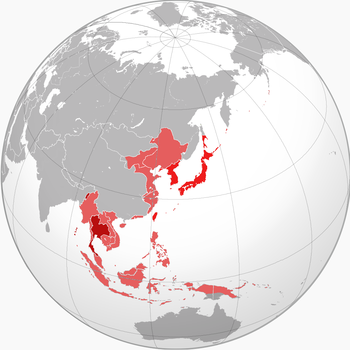
| Greater East Asia Co-Prosperity Sphere | |||||
|---|---|---|---|---|---|
| Japanese name | |||||
| Kana | だいとうあきょうえいけん | ||||
| Kyūjitai | 大東亞共榮圈 | ||||
| Shinjitai | 大東亜共栄圏 | ||||
| |||||
The Greater East Asia Co-Prosperity Sphere (Japanese: 大東亞共榮圈, Hepburn: Dai Tōa Kyōeiken), also known as the GEACPS,[1] was a pan-Asian union that the Empire of Japan tried to establish. Initially, it covered Japan (including annexed Korea), Manchukuo, and China, but as the Pacific War progressed, it also included territories in Southeast Asia and parts of India.[2] The term was first coined by Minister for Foreign Affairs Hachirō Arita on June 29, 1940.[3]
The proposed objectives of this union were to ensure economic self-sufficiency and cooperation among the member states, along with resisting the influence of Western imperialism and Soviet communism.[4] In reality, militarists and nationalists saw it as an effective propaganda tool to enforce Japanese hegemony.[3] The latter approach was reflected in a document released by Japan's Ministry of Health and Welfare, An Investigation of Global Policy with the Yamato Race as Nucleus, which promoted racial supremacist theories.[5] Japanese spokesmen openly described the Greater East Asia Co-Prosperity Sphere as a device for the "development of the Japanese race."[6] When World War II ended, the Greater East Asia Co-Prosperity Sphere became a source of criticism and scorn for Allies.[7]
- ^ Matthiessen, Sven (2015). Japanese Pan-Asianism and the Philippines from the Late Nineteenth Century to the End of World War II: Going to the Philippines Is Like Coming Home?. BRILL. ISBN 9789004305724.
- ^ William L. O'Neill, A Democracy at War: America's Fight at Home and Abroad in World War II. Free Press, 1993, p. 53. ISBN 0-02-923678-9
- ^ a b Colegrove, Kenneth (1941). "The New Order in East Asia". The Far Eastern Quarterly. 1 (1): 5–24. doi:10.2307/2049073. JSTOR 2049073. S2CID 162713869 – via JSTOR.
- ^ W. Giles, Nathaniel (2015). "The Greater East Asia Co-Prosperity Sphere: The Failure of Japan's 'Monroe Doctrine' for Asia". Undergraduate Honors Theses (295): 2–34 – via East Tennessee State University Digital Commons.
- ^ Dower, John W. (1986). War Without Mercy: Race & Power in the Pacific War (1st ed.). New York: Pantheon Books. pp. 262–290. ISBN 039450030X. OCLC 13064585.
- ^ "The Greater East Asia Co-Prosperity Sphere" (PDF). United States Central Intelligence Agency. 10 August 1945. Retrieved 31 July 2021.
- ^ "Greater East Asia Co-Prosperity Sphere". A Dictionary of World History. Oxford University Press. Retrieved 31 July 2021.